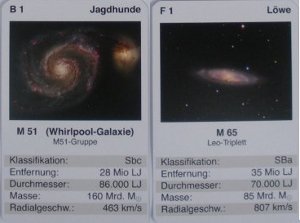Standard

The left galaxy beats the right one with "Durchmesser" and "Masse".
Variants
There can be optional variants and sub-rules that should be fixed before starting the game.- The "best" score has to be agreed upon! In most cases, the higher value gives the asset, but under some circumstances the lower value will be advantageous. Example: The astronomical brightness runs for the smaller values; the smaller value (even negative) means the brighter star!

Please, pay attention to the suggestions on the extra card explaining the range of the astronomical parameters. - The deck Kometen is intentionally designed for the lower parameter values; however, except of "Bahnperiode" and "Entdeckung" to be won by the higher and older values, respectively.
- If a player gains a complete book ("quart") within his stack, he wants to lay them aside; these cards cannot be lost anymore. The player possessing the most books at the end wins.
- The game can be constrained by time, unless it might last for very long.
Extra cards
The extra cards are just supplementary and can be disregarded by taking them out of the deck, if uncomfortable.
- The Joker, if present, allows to alter the parameter chosen by the active player to the interest of the card owner. However, the scores of the joker are treated in the same way as any other. If unsuccessful, this card can be lost.
- If agreed among the players, a Joker could also be used as a backfill for a book. Though it will get off the active cards then, while another regular card would remain without a membership to a book.
- The "Initial" card is meant to determine the first player by the chance of shuffling. That card is only present in the decks Raumsonden and Exoplaneten.
Creativity
The card game offers a playground for your own rules. The decks Mission Cassini and Sterne have a different design. The former employs colors and topics of five ("quintet"), the latter does not display a book/series.The purpose of the astronomical card games is to become acquainted with the scientific parameters and their valid ranges. Each game is technically playable, i.e. all parameters were carefully chosen to make a comparison of the objects as meaningful as possible.